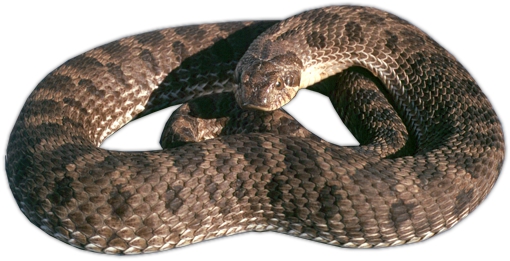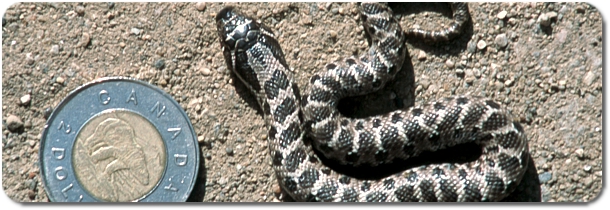Western Hognose Snake

What it looks like
The Western Hognose Snake is a medium sized snake that grows to about 80 cm long. Females are larger than males. The body is thick, about 3-4 cm across. The colour is gray and brown with darker brown spots. The belly is black. It has an upturned snout.
Look-alikes
In Manitoba there are no snakes that look like the Western Hognose Snake. Our other snakes are much thinner and are different colours. Garter snakes are black with long, yellow stripes down their sides. Some people think a Western Hognose Snake looks like a rattlesnake, but there are no rattlesnakes in Manitoba.
Name
The "hognose" part of this snake's name comes from its upturned pig-like (or hog-like) snout. There are two kinds of hognose snakes in central North America, one in the east and one in the west. Ours is the Western Hognose Snake.
Scientific Name
The Western Hognose Snake's scientific name is Heterodon nasicus. Learn what that means on this page: Scientific Names.
Where it lives
Western Hognose Snakes are found in the central Great Plains, or prairies, of North America. In Manitoba they are found only in areas of very sandy soils in the southwest corner of the province. They prefer grassland habitats, but will move into nearby forests, too.
Where Western Hognose Snakes live in North America.
Habits
Western Hognose Snakes hunt for food during the day and hide in burrows at night. They don't travel far from their burrows, but may visit nearby forests and wetlands to hunt.
They spend winter underground, down holes or animal burrows that let them get below where the frost can reach. In Manitoba Western Hognose Snakes are only active from late April until October.
Food Web
The Western Hognose Snake is a predator of other reptiles and amphibians. It will eat all kinds of frogs and toads as well as lizards and other snakes. Toads are one of its favourite foods. A large Western Hognose Snake can catch and eat a garter snake that is as long as it is!
These snakes may be eaten by larger animals like skunks, raccoons and foxes or birds such as hawks, owls or herons.
Life Cycle
Western Hognose Snakes mate in spring when they leave their winter dens. Females dig a shallow nest in sandy soil and lay 5 - 10 eggs. Most eggs are laid in July and hatch from mid-August to September. Hatchlings are about 15 cm long. It takes 3 to 4 years to grow to adult size. They may live for 15 - 20 years.

The size of a newly hatched Western Hognose Snake. (Photo by Neil Gushulak)
Numbers
Western Hognose Snakes are uncommon in Manitoba. In the sandy habitats where they are found in the southwest there may be only 2 or 3 in every hectare.
Special Things
These snakes use their upturned snout to dig into sand and bury themselves to hide. To defend itself a Western Hognose Snake may flatten its head and hiss, pretending to be a rattlesnake, or it will roll over and play dead. It releases a bad smell to make a predator think it has been dead for a while. Western Hognose Snakes are rare in Manitoba and need to be protected.
How to Find Western Hognose Snakes
On cool mornings snakes find places where they can lie in the sun to warm up. In areas of very sandy soils in southwestern Manitoba you may find this snake basking on the edge of roads or trails.
Use by People
Western Hognose Snakes are rarely seen by people. Some people try to keep them as pets, but they should never be taken from the wild.
| Go to: Smooth Green Snake | Back to: Amphibians and Reptiles Front Page |
For more on the Western Hognose Snake in NatureNorth.com follow this link:
